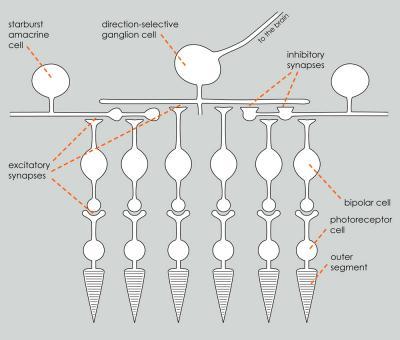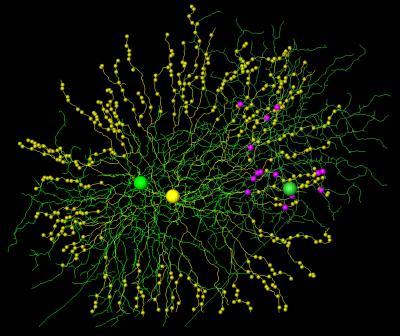Max Planck researchers Kevin Briggman, Moritz Helmstaedter and Winfried Denk have now discovered that, although the cells themselves are symmetrical, the synapses between retinal ganglion cells and starburst amacrine cells are distributed asymmetrically: seen from the ganglion cell, the starburst cell dendrites connected with it run in the direction opposite to the preferred direction of motion. "Ganglion cells prefer amacrine-cell dendrites that run along the null-direction," says Winfried Denk.
According to previous studies by Winfried Denk and his research group, the electrical characteristics of the dendrites, which emerge starlike from the cell bodies of amacrine cells, play a crucial role here. The further they are located from the centre of the cell toward the edge, the easier they are to excite; therefore, stimuli are transmitted preferentially in this direction. This mechanism does not require but is helped by inhibitory influences between neighbouring amacrine cells, known as lateral inhibition. "A ganglion cell can thus differentiate between movements from different directions simply by making connections with certain starburst amacrine cell dendrites - namely those that prevent activation of the ganglion cell in null-direction through their inhibitory synapses. These are precisely the amacrine cell dendrites that run along this direction," explains Winfried Denk.

Ganglion cells preferentially form synapses with those amacrine cells whose dendrites run in the direction opposite -- seen from the ganglion cell - to the preferred direction of motion (amacrine cell on the rigt). A visual cue running from left to right activates (red) the ganglion cell via the synapses of the bipolar cells. A cue running from right to left makes the amacrine cell synapses to inhibit the ganglion cell (blue) before it is activated by the bipolar cells.
(Photo Credit: www.somedonkey.com)
Functional and structural analysis
This discovery was made possible by combining two different microscopy methods. The scientists succeeded, first, in determining the preferred motion direction of the ganglion cells using a two-photon fluorescence microscope. A calcium-sensitive fluorescent dye indicated in response to which stimuli calcium flows into the cells - a process that signals electrical activity in cells.
They then measured the exact trajectory of all of the dendrites of these ganglion cells and those of connected amacrine cells with the help of a new electron microscopy method known as serial block face electron microscopy. This process enabled them to produce a volumetric image by repeatedly scanning the surface of a tissue sample using the electron beam of a scanning electron microscope. A thin "slice" is shaved off the sample surface after each scan is complete, using an extremely sharp diamond knife. These slices are thinner than 25 nanometers, just about one thousandth of the thickness of a human hair.
The high three-dimensional resolution of this method enabled the scientists to trace the fine, densely packed branched dendrites of retinal neurons and clearly identify the synapses between them. The complete automation of the imaging process enables them to record data sets with thousands and even tens of thousands of sections "while on holiday or attending a conference," says Winfried Denk. "For the first time, minute cell structures can now be viewed at a high resolution in larger chunks of tissue. This procedure will also play an indispensable role in the clarification of the circuit patterns of all regions of the nervous system in the future."

In the outer segments of the photo receptor cells the optic signals are transduced into electrical signals. Excitatory and inhibitory synapses convey these signals to the ganglion cells.
(Photo Credit: www.somedonkey.com)

Cells and synapses reconstructed from serial block face electron microscopy data. A single starburst amacrine cell (yellow, note synaptic varicosities) and two direction-selective ganglion cells (green). Even though there is substantial dendritic overlap with both cells, all connections (magenta) go to the right ganglion cell.
(Photo Credit: Kevin Briggman)
Source: Max-Planck-Gesellschaft